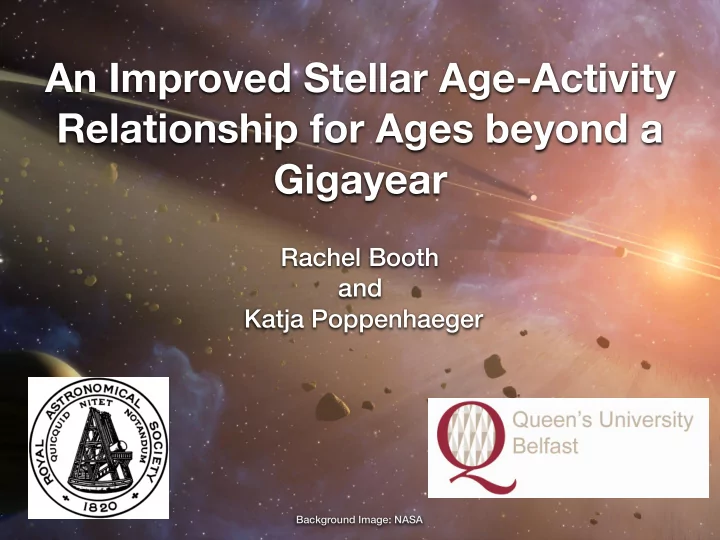

An Improved Stellar Age-Activity Relationship for Ages beyond a Gigayear Rachel Booth and Katja Poppenhaeger Background Image: NASA
Age Relationships • Two types: - Gyrochronology - Magnetic Activity • Magnetic Braking causes the change in rotation • This has an effect on the Meibom et al., 2015 Stellar Dynamo
Age Relationships • Require calibrator stars • Asteroseismology - Ages of field stars • Main methods of studying Magnetic Activity: - Calcium II H and K - X-ray Luminosity • Study Activity-Age NASA/JPL-Caltech/GSFC Relationship beyond a gigayear
Observations • List of target stars - Asteroseismology Studies Aguirre et al. (2015), Chaplin et al. (2014) ‣ - Systems with well known ages - Star - White Dwarf Binaries • Searched archive of XMM- Newton and Chandra X-ray Telescopes • Some dedicated observations Examples of X-Ray Observations. from PI Poppenhaeger Top: Chandra Bottom: XMM-Newton
Spectral Modelling
Previous Studies of Age and Activity • Stelzer & Neuhäuser (2001) - Sample of T Tauri Stars • Preibisch et al. (2005) - Sample of Pre Main Sequence Stars • Jackson et al. (2012) - Sample of Clusters
Previous Studies of Age and Activity • Stelzer & Neuhäuser (2001) - Sample of T Tauri Stars Lack of • Preibisch et al. (2005) calibrators older - Sample of Pre Main Sequence Stars than a gigayear • Jackson et al. (2012) - Sample of Clusters
Previous Studies of Age and Activity Data taken from Jackson et al., 2012
Preliminary Results Cluster data taken from Jackson et al., 2012
Theoretical Relationship Pizzolato et al., 2003 Skumanich, 1972
Theoretical Relationship Pizzolato et al., 2003 Skumanich, 1972
Possible Explanations • Rotational Spin down is more rapid - Recent evidence for weakened magnetic braking (van Saders et al. 2016) - Theoretical Work (Garraffo et al. 2015, Vidotto et al. 2016) Rotation Period (days) Age (Gyr) van Saders et al., 2016
Possible Explanations • Activity-Rotation relationship changes - Some evidence for steepening activity-rotation relationship - More research is needed to confirm Wright et al., 2011
Conclusions • Investigation of the Activity- Age relationship beyond a gigayear • Data suggests a steeper relationship than previously found • This could be caused by: • More rapid Rotational spin- down Cluster data taken from Jackson et al., 2012 • Or a change in the Activity- Rotation relationship
Lx / Stellar Surface • Similar spread for cool stars of different mass Lx / Stellar surface F G K M dwarfs Schmitt (1997) B-V
Recommend
More recommend